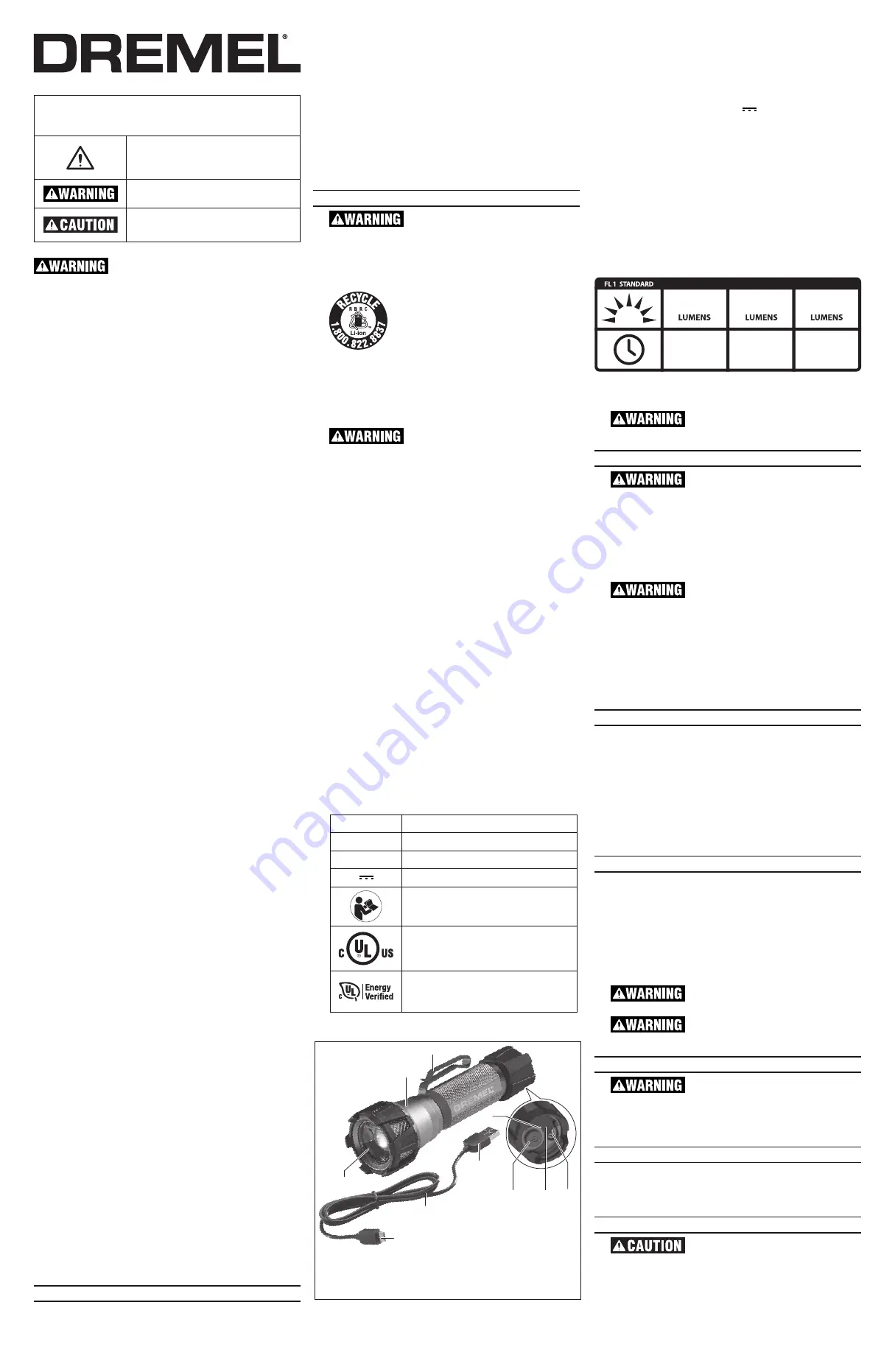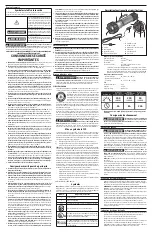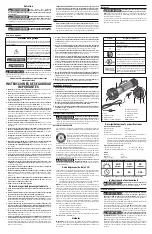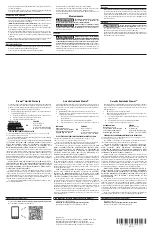
Read all safety warnings and instructions.
Failure to fol-
low the warnings and instructions may result in electric
shock, fire and/or serious injury.
SAVE ALL WARNINGS AND INSTRUCTIONS FOR FUTURE REFERENCE
IMPORTANT SAFETY
INSTRUCTIONS
a. Keep work area clean and well lit.
Cluttered or dark areas invite accidents.
b. Do not allow children to use the flashlight.
Children can unintentionally blind
themselves or other persons.
c. Do not direct the light beam at persons or animals and do not stare into
the light beam yourself (not even from a distance).
Serious eye injury could
occur.
d. Do not operate flashlight in explosive atmospheres, such as in the pres-
ence of flammable liquids, gases or dust.
Flashlight creates heat and sparks
which may ignite the dust or fumes.
e. To reduce the risk of fire, personal injury, and product damage due to a
short circuit, never immerse your flashlight in fluid or allow a fluid to flow
inside them.
Corrosive or conductive fluids, such as seawater, certain indus-
trial chemicals, and bleach or bleach containing products, etc., can cause a
short circuit.
f.
Do not place or store flashlight where it can fall or be pulled into a tub or sink.
g. Do not cover the lens while operating the flashlight.
The lens heats up dur-
ing operation and can cause burns or fire when the heat accumulates.
h. Do not position the lighted flashlight head on or near flammable or com-
bustible materials.
The lens gets hot during use.
i.
Do not touch the lens while the flashlight is in operation.
Touching hot lens
increases the risk of personal injury.
j.
Do not splash the lens of lighted flashlight with liquids.
Hot lens may shatter
when cooler liquids are contacted.
k. After the automatic shut-off of the flashlight, do not continue to press the
On/Off button.
The battery could become damaged.
l.
The flashlight is ruggedly constructed.
It should, however, be handled with
care.
m. Keep handles and grasping surfaces dry, clean and free from oil and
grease.
Slippery handles and grasping surfaces do not allow for safe handling
and control of the flashlight in unexpected situations.
n. Follow all charging instructions and do not charge the flashlight outside
the temperature range specified in the instructions.
Charging improperly
or at temperatures outside the specified range may damage the battery and
increase the risk of fire.
o. Check the battery charge level at least once a month, especially if used
for emergency purposes.
Recharge the battery if charge level is low.
p. Do not modify or attempt to repair the flashlight except as indicated in the
instructions for use and care.
q. Do not use a battery pack or flashlight that is damaged or modified.
Dam-
aged or modified batteries may exhibit unpredictable behavior resulting in fire,
explosion or risk of injury.
r.
Remove the USB cable from the flashlight before any work on the flash-
light itself (e.g. assembling, maintenance, cleaning, etc.), as well as when
transporting and storing.
s. Use only original Dremel accessories.
Battery Charging Safety Rules
a. This manual contains instructions for the battery charger in the Dremel flash-
light.
b. Before using the flashlight, read all instructions and cautionary markings on
(1) USB power supply, and (2) the flashlight.
c. Use only Dremel 510 power supply or Listed/certified USB power supply to
charge the flashlight.
Using other type of power supply may cause property
damage or personal injury and fire.
d. Charge flashlight in temperatures above +32 degrees F (0 degrees C) and
below +104 degrees F (40 degrees C). Store flashlight in locations where
temperatures will not exceed 113 degrees F (45 degrees C).
This is important
to prevent serious damage to the battery cells.
e. Do not recharge flashlight in damp or wet environment. Do not expose flash-
light to rain or snow.
Water entering flashlight may result in electric shock or fire.
f.
Place flashlight on flat nonflammable surfaces and away from flammable ma-
terials when recharging flashlight.
Carpeting and other heat insulating surfaces
block proper air circulation, which may cause overheating of the flashlight. If
smoke or melting of the flashlight is observed, unplug the flashlight immediately
and do not use the flashlight. Contact customer service immediately.
g. Make sure USB cable is located so that it will not be stepped on, tripped over,
or otherwise subjected to damage or stress.
Damaged plug and cable may result
in electric shock or fire.
h. Disconnect the flashlight by pulling the USB plug rather than the cable. Do
not charge flashlight with damaged USB cable; have it replaced immediately.
Damaged USB cable may result in electric shock or fire.
i.
Do not disassemble flashlight or operate the flashlight if it has received a
sharp blow, been dropped or otherwise damaged in anyway.
Incorrect re-
assembly or damage may result in electric shock or fire.
j.
Before each use, check the flashlight and USB cable. If damage is detected,
do not use the flashlight and USB cable. Never open the flashlight yourself.
Take it to a Dremel Factory Service Center or qualified serviceman only using
original spare parts.
Incorrect reassembly may result in electric shock or fire.
k. Unplug the flashlight from USB cable and USB power supply when battery in
the flashlight is fully charged.
Flashlight left connected to USB power supply
over a long period of time could lead to flashlight damage and fire.
l.
Unplug the flashlight from USB cable and USB power supply before storage,
attempting any maintenance or cleaning.
Such preventive safety measures re-
duce the risk of electric shock or fire.
m. Keep the flashlight clean by wiping the flashlight housing with a damp cloth.
Contamination may result in electric shock or fire.
Battery Care
a. DO NOT PUT BATTERIES INTO FIRE OR EXPOSE TO HIGH HEAT.
They may ex-
plode.
b. Battery leakage may occur under extreme usage or temperature conditions.
Avoid contact with skin and eyes.
The battery liquid is caustic and could cause
chemical burn to tissues. If liquid comes in contact with skin, wash quickly with
soap and water. If the liquid contacts your eyes, flush them with water for a mini-
mum of 10 minutes and seek medical attention.
c. Do not store battery or battery operated flashlight in damp locations where
corrosion of terminals may occur.
d. Do not store battery or battery operated flashlight at high temperature (over
113°F / +45°C).
This is important to prevent serious damage to the battery cells.
Battery Disposal
Do not attempt to disassemble the flashlight or re-
move any component projecting from the flash-
light.
Fire or injury may result. Prior to disposal, protect exposed terminals
with heavy insulating tape to prevent shorting.
LITHIUM-ION BATTERIES
If equipped with a lithium-ion battery, the battery must be collected, recycled
or disposed of in an environ mentally sound manner.
“The EPA certified RBRC Battery Recycling Seal on the
lithium-ion (Li-ion) battery indicates Robert Bosch Tool
Corporation is voluntarily participating in an industry pro-
gram to collect and recycle these batteries at the end of
their useful life, when taken out of service in the United
States or Canada. The RBRC program provides a conven-
ient alterative to placing used Li-ion batteries into the trash or the munici pal
waste stream, which may be illegal in your area.
Please call 1-800-8-BATTERY for information on Li-ion battery recycling and
disposal bans/restrictions in your area, or return your batteries to a
Bosch/Dremel Service Center for recycling. Robert Bosch Tool Corporation’s
involvement in this program is part of our commitment to preserving our en-
vironment and conserving our natural resources.”
Do not open the flashlight or attempt to remove
battery from your flashlight.
Dispose of flashlight
through your local waste removal authority or a Bosch/Dremel Service Cen-
ter.
FCC Caution
The manufacturer is not responsible for radio interference caused by unau-
thorized modifications to this equipment. Such modifications could void the
user’s authority to operate the equipment.
This device complies with Part 15 of the FCC Rules. Operation is subject to
the following two conditions:
1)
This device may not cause harmful interference, and
2)
This device must accept any interference received, including interference
that may cause undesired operation.
NOTE!
This equipment has been tested and found to comply with the limits
for a Class B digital devices, pursuant to Part 15 of the FCC rules. These limits
are designed to provide reasonable protection against harmful interference
in a residential installation. This equipment generates, uses and can radiate
radio frequency energy and, if not installed and used in accordance with the
instructions, may cause harmful interference to radio communications. How-
ever, there is no guarantee that interference will not occur in a particular in-
stallation. If this equipment does cause harmful interference to radio or
television reception, which can be determined by turning the equipment off
and on, the user is encouraged to try to correct the interference by one or
more of the following measures:
•
Reorient or relocate the receiving antenna.
•
Increase the separation between the equipment and receiver.
•
Connect the equipment into an outlet on a circuit different from that to
which the receiver is connected.
•
Consult the dealer or an experienced radio/TV technician for help.
CAN ICES-005 (B) / NMB-005 (B)
Symbols
Important:
Some of the following symbols may be used on your flashlight.
Please study them and learn their meaning. Proper interpretation of these
symbols will allow you to operate the flashlight better and safer.
Functional Description and Specifications
Cordless Flashlight HSFL-01
Symbol
Designation / Explanation
V
Volts (voltage)
A
Amperes (current)
Direct current (type or a characteristic of current)
Alerts user to read manual
This symbol designates that this flashlight is listed
by Underwriters Laboratories, to United States and
Canadian Standards.
This symbol designates that this product is verified
by Underwriters Laboratories to comply with Natu-
ral Resources Canada energy efficiency standards.
Model number . . . . . . . . . . . . .HSFL-01
Voltage rating . . . . . . . . . . . . . .3.6V / 4V
Max
USB Input . . . . . . . . . . . . . . . . .5 V
Ingress protection . . . . . . . . . .IP67 valid only with Micro-USB cover closed
IP67 rating indicates the flashlight is protected from temporary immersion
in water (with power off, the flashlight can be immersed in 3.28ft. (1m) of
water for 30 minutes with no harmful effects). Testing is performed on a
new flashlight.
Allowed ambient temperature
– during charging . . . . . . . . . . .32...104 °F (0...+40 °C)
– during operation/storage . . .14...113 °F (–10...+45 °C)
Battery
Chemistry . . . . . . . . . . . . . . . . .Li-ion
Capacity . . . . . . . . . . . . . . . . . .2.5 Ah
Charge time . . . . . . . . . . . . . . .approx. 5 Hr.
Beam distance: 650 feet (in high, spot mode)
Operating Instructions
Do not point the light beam at persons and do not
stare into the light beam yourself.
Bright light may
cause personal injury.
Charging
Do not charge flashlight when Micro-USB port is
wet. Allow the Micro-USB port to dry out prior to
charging flashlight.
Moisture on USB port during charge may cause fire, se-
rious personal injury and/or property damage.
Your Dremel Flashlight comes partially charged from the factory. Be sure to
fully charge the flashlight before using it.
To charge the flashlight, insert USB plug
10
in a USB compliant device. Lift
the Micro-USB Cover
5
. Insert the micro USB plug
9
into Micro-USB port
6
.
Once charging is complete, remove the Micro-USB plug and close the Micro-
USB Cover to protect your flashlight.
After charging flashlight, ensure the Micro-USB
cover is completely closed.
Moisture entering flash-
light may cause fire, serious personal injury and/or property damage.
Note:
The Flashlight cannot be used during the charging process.
The LED indicator
7
will flash green during the charging process. When the
battery is fully charged, the LED indicator will be solid green. Unplug the
power supply from the power outlet.
Flashing Red and Orange: Temperature fault. Allow the flashlight to cool down
before using.
Rapid flashing of green and red indicates that the battery is damaged and can-
not be charged. Contact the Dremel Service Center.
Using the Flashlight
Press the on/off button
4
to turn the flashlight on. Press the on/off button
again to change from high to medium and low settings.
NOTE! There are two ways to turn off the flashlight.
From the low setting,
press the on/off button and the light will turn off.
From any setting, hold the on/off button for 2 seconds and the flashlight will
turn off.
Twist the focus adjustment
2
to change between spot and flood settings. After
focus adjustment, always check the Micro-USB cover
5
to ensure it is closed
to prevent water from getting inside the flashlight.
When using the belt clip
3
, ensure the belt clip is fully engaged to prevent the
flashlight from falling off or coming loose.
Battery Indicator
If you press the on/off button
4
, the battery indicator
7
will show the battery
status for 3 seconds
Solid Green: Battery Capacity is greater than 40%
Solid Orange: Battery Capacity is less than 40%
Flashing Red: Battery Capacity is critically low. Flashlight may turn off unex-
pectedly. Charge the flashlight.
Flashing Red and Orange: Temperature fault. Allow the flashlight to cool down
before using.
Maintenance
To avoid accidents, always disconnect the flash-
light and/or power supply from the power outlet
before cleaning.
Before each use, check condition of Micro-USB
cover for proper water sealing.
If damage is sus-
pected, contact customer service.
Service
NO USER SERVICE ABLE PARTS INSIDE. Preven-
tive maintenance performed by un au thorized per-
sonnel may result in misplacing of internal wires and components which
could cause serious hazard.
We recom mend that all tool service be per-
formed by a Dremel Service Center. SERVICE MEN: Disconnect tool and/or
charger from power source before servicing.
Batteries
Be alert for battery packs that are nearing their end of life.
If you notice
decreased tool performance or significantly shorter running time between
charges then it is time to replace the battery pack. Failure to do so can cause
the tool to operate improperly or damage the charger.
Cleaning
Certain cleaning agents and solvents damage
plastic parts.
Some of these are: gasoline, car bon
tetrachloride, chlorinated cleaning solvents, ammonia and household deter-
gents that contain ammonia.
Ventilation openings and switch levers must be kept clean and free of foreign
matter. Do not attempt to clean by inserting pointed objects through open-
ing.
3
1
2
4
7
5
6
8
9
10
HSFL-01
1.
Lens
2.
Focus adjustment
3.
Belt clip
4.
On/off button
5.
Micro-USB cover
6.
Micro-USB port
7.
Battery indicator
8.
USB cable
9.
Micro-USB plug
10.
USB plug
8
h
200
24
h
50
4
h
500
Medium, flood
Low, flood
High, flood
Safety Symbols
The definitions below describe the level of severity for each signal word.
Please read the manual and pay attention to these symbols.
This is the safety alert symbol. It is used to alert you
to potential personal injury hazards. Obey all safety
messages that follow this symbol to avoid possible
injury or death.
WARNING indicates a hazardous situation which, if
not avoided, could result in death or serious injury.
CAUTION indicates a hazardous situation which, if
not avoided, could result in minor or moderate in-
jury.






















